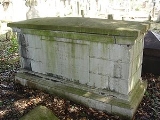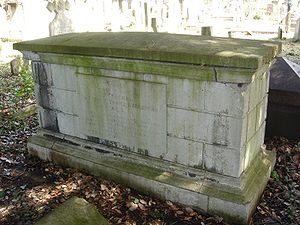
Frederick Traill-Burroughs
Encyclopedia
Lt-General Sir Frederick William Traill-Burroughs KCB
CMG
(1831 – 9 April 1905) was a British army officer.

.
In 1854, he went to Crimea
with the regiment. He fought at the Battle of Alma
where the 93rd were part of The Thin Red Line
. Despite many casualties caused by fever, cholera and dysentery as well as enemy action, his own health was good. The regiment was in the front line at Sebastopol when the war ended. They were preparing to assault the town - it is said with Burroughs leading the first wave of the Highland Brigade - but discovered next morning that the enemy had withdrawn during the previous night so he missed his moment of potential glory.
Burroughs was also one of the first - if not the very first - through the breaches at the besieged town of Lucknow in the 1857 Rebellion in India, for which he was recommended by the men of his Regiment for a VC, although due to internal military politics this was not awarded.
In 1864 he was promoted to lieutenant-colonel and commanded the regiment in bitter fighting in the North West Frontier. He and the regiment returned home in 1870 and after a spell in command at Edinburgh Castle he eventually retired from the army in 1873.
From 1897-1904, he was Colonel-in-Chief of the Royal Warwickshire Fusiliers.
, Orkney in July 1870. Traill-Burroughs had inherited much of the island and gradually bought more of it. He also built a large house at Trumland
, designed by David Bryce
of Edinburgh
. From 1870-83, there were a large number of improvements; the building of Trumland pier, island schools, a public market, the first steamship service, a post office, and the first resident doctor. He was known locally as 'the little general' as he was a man of short stature and the poet Edwin Muir recalled in a memoir of his childhood seeing the little general walking around his estates.
Throughout the 19th century, Rousay landlords demanded higher rents from crofters, many of whom were moved in a series of clearances to the far side of Rousay, ordered by previous landowner George William Traill.
, London.
There is also a memorial to him in Kirkwall Cathedral.
Order of the Bath
The Most Honourable Order of the Bath is a British order of chivalry founded by George I on 18 May 1725. The name derives from the elaborate mediæval ceremony for creating a knight, which involved bathing as one of its elements. The knights so created were known as Knights of the Bath...
CMG
Order of St Michael and St George
The Most Distinguished Order of Saint Michael and Saint George is an order of chivalry founded on 28 April 1818 by George, Prince Regent, later George IV of the United Kingdom, while he was acting as Prince Regent for his father, George III....
(1831 – 9 April 1905) was a British army officer.

Early life
He was born in 1831, the eldest of five children, to General Frederick William Burroughs and Caroline de Peyron, at Fatehgarh (a military post) on the banks of the Ganges not far from Cawnpore, IndiaIndia
India , officially the Republic of India , is a country in South Asia. It is the seventh-largest country by geographical area, the second-most populous country with over 1.2 billion people, and the most populous democracy in the world...
.
Military career
Aged 17, he joined the 93rd (Highland) Regiment, as an ensign.In 1854, he went to Crimea
Crimea
Crimea , or the Autonomous Republic of Crimea , is a sub-national unit, an autonomous republic, of Ukraine. It is located on the northern coast of the Black Sea, occupying a peninsula of the same name...
with the regiment. He fought at the Battle of Alma
Battle of Alma
The Battle of the Alma , which is usually considered the first battle of the Crimean War , took place just south of the River Alma in the Crimea. An Anglo-French force under General St...
where the 93rd were part of The Thin Red Line
The Thin Red Line (1854 battle)
The Thin Red Line was a military action by the Sutherland Highlanders red-coated 93rd Regiment at the Battle of Balaclava on October 25, 1854, during the Crimean War. In this incident the 93rd aided by a small force of Royal Marines and some Turkish infantrymen, led by Sir Colin Campbell, routed a...
. Despite many casualties caused by fever, cholera and dysentery as well as enemy action, his own health was good. The regiment was in the front line at Sebastopol when the war ended. They were preparing to assault the town - it is said with Burroughs leading the first wave of the Highland Brigade - but discovered next morning that the enemy had withdrawn during the previous night so he missed his moment of potential glory.
Burroughs was also one of the first - if not the very first - through the breaches at the besieged town of Lucknow in the 1857 Rebellion in India, for which he was recommended by the men of his Regiment for a VC, although due to internal military politics this was not awarded.
In 1864 he was promoted to lieutenant-colonel and commanded the regiment in bitter fighting in the North West Frontier. He and the regiment returned home in 1870 and after a spell in command at Edinburgh Castle he eventually retired from the army in 1873.
From 1897-1904, he was Colonel-in-Chief of the Royal Warwickshire Fusiliers.
Rousay
On his return from India, he and his wife, Eliza (Lizzie) D’Oyley Geddes, visited RousayRousay
Rousay is a small, hilly island about north of Orkney's Mainland, off the north coast of Scotland, and has been nicknamed "the Egypt of the north", due to its tremendous archaeological diversity and importance....
, Orkney in July 1870. Traill-Burroughs had inherited much of the island and gradually bought more of it. He also built a large house at Trumland
Trumland
Trumland is a Category B listed house and associated estate on Rousay, in Orkney, Scotland, built in its present form in 1875. Designed by David Bryce, the house was commissioned by Sir F W Traill-Burroughs in 1870, as a new family home for himself on his return from India.Overlooking the sound...
, designed by David Bryce
David Bryce
David Bryce FRSE FRIBA RSA was a Scottish architect. Born in Edinburgh, he was educated at the Royal High School and joined the office of architect William Burn in 1825, aged 22. By 1841, Bryce had risen to be Burn's partner...
of Edinburgh
Edinburgh
Edinburgh is the capital city of Scotland, the second largest city in Scotland, and the eighth most populous in the United Kingdom. The City of Edinburgh Council governs one of Scotland's 32 local government council areas. The council area includes urban Edinburgh and a rural area...
. From 1870-83, there were a large number of improvements; the building of Trumland pier, island schools, a public market, the first steamship service, a post office, and the first resident doctor. He was known locally as 'the little general' as he was a man of short stature and the poet Edwin Muir recalled in a memoir of his childhood seeing the little general walking around his estates.
Throughout the 19th century, Rousay landlords demanded higher rents from crofters, many of whom were moved in a series of clearances to the far side of Rousay, ordered by previous landowner George William Traill.
Later life
Traill-Burroughs died in London on 9 April 1905, and is buried in Brompton CemeteryBrompton Cemetery
Brompton Cemetery is located near Earl's Court in South West London, England . It is managed by The Royal Parks and is one of the Magnificent Seven...
, London.
There is also a memorial to him in Kirkwall Cathedral.

